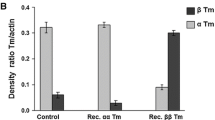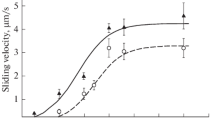Abstract
This study contributes to understand the physiological role of slow myosin light chain isoforms in fast-twitch type IIA fibres of skeletal muscle. These isoforms are often attached to the myosin necks of rat type IIA fibres, whereby the slow alkali myosin light chain isoform MLC1s is much more frequent and abundant than the slow regulatory myosin light chain isoform MLC2s. In the present study, single-skinned rat type IIA fibres were maximally Ca2+ activated and subjected to stepwise stretches for causing a perturbation of myosin head pulling cycles. From the time course of the resulting force transients, myosin head kinetics was deduced. Fibres containing MLC1s exhibited slower kinetics independently of the presence or absence of MLC2s. At the maximal MLC1s concentration of about 75%, the slowing was about 40%. The slowing effect of MLC1s is possibly due to differences in the myosin heavy chain binding sites of the fast and slow alkali MLC isoforms, which changes the rigidity of the myosin neck. Compared with the impact of myosin heavy chain isoforms in various fast-twitch fibre types, the influence of MLC1s on myosin head kinetics of type IIA fibres is much smaller. In conclusion, the physiological role of fast and slow MLC isoforms in type IIA fibres is a fine-tuning of the myosin head kinetics.



Similar content being viewed by others
References
Abbott RH, Steiger GJ (1977) Temperature and amplitude dependence of tension transients in glycerinated skeletal and insect fibrillar muscle. J Physiol 266:13–42
Andreev OA, Saraswat LD, Lowey S, Slaughter C, Borejdo J (1999) Interaction of the N-terminus of chicken skeletal essential light chain 1 with F-actin. Biochemistry 38:2480–2485
Andruchov O, Andruchova O, Wang Y, Galler S (2004) Kinetic properties of myosin heavy chain isoforms in mouse skeletal muscle: comparison with rat, rabbit and human and correlation with amino acid sequence. Am J Physiol Cell Physiol 287:C1725–C1732
Andruchov O, Wang Y, Andruchova O, Galler S (2004) Functional properties of skinned rabbit skeletal and cardiac muscle preparations containing α-cardiac myosin heavy chain. Pflugers Arch 448:44–53
Andruchov O, Andruchova O, Wang Y, Galler S (2006) Dependence of cross-bridge kinetics on myosin light chain isoforms in rabbit and rat skeletal muscle fibres. J Physiol 571:231–242
Aydt EM, Wolff G, Morano I (2007) Molecular modelling of myosin-S1(A1) isoform. J Struct Biol 159:158–163
Bicer S, Reiser PJ (2004) Myosin light chain isoform expression among single mammalian skeletal muscle fibers: species variations. J Muscle Res Cell Motil 25:622–633
Bortolotto SK, Stephenson DG, Stephenson GM (2000) MHC isoforms composition and Ca2+—or Sr2+—activation properties of rat skeletal muscle fibers. Am J Physiol Cell Physiol 279:C1564–C1577
Bottinelli R (2001) Functional heterogeneity of mammalian single muscle fibres: do myosin isoform tell the whole story? Pflugers Arch 443:6–17
Bottinelli R, Betto R, Schiaffino S, Reggiani C (1994) Unloaded shortening velocity and myosin heavy chain and alkali light chain isoform composition in rat skeletal muscle fibres. J Physiol 478:341–349
D’Antona G, Megighian A, Bortolotto S, Pellegrino MA, Ragona RM, Staffieri A, Bottinelli R, Reggiani C (2002) Contractile properties and myosin heavy chain isoform composition in single fibre of human laryngeal muscles. J Muscle Res Cell Motil 23:187–195
Danieli-Betto D, Betto R, Midrio M (1990) Calcium sensitivity and myofibrillar protein isoforms of rat skinned skeletal muscle fibres. Pflugers Arch 417:303–308
Davis JS, Satorius CL, Epstein ND (2002) Kinetic effects of myosin regulatory light chain phosphorylation on skeletal muscle contraction. Biophys J 83:359–370
Ford LE, Huxley AF, Simmons RM (1977) Tension responses to sudden length change in stimulated frog muscle fibres near slack length. J Physiol 269:441–515
Galler S, Hilber K (1994) Unloaded shortening of skinned mammalian skeletal muscle fibres. Effects of the experimental approach and passive force. J Muscle Res Cell Motil 15:400–412
Galler S, Schmitt T, Pette D (1994) Stretch activation, unloaded shortening velocity, and myosin heavy chain isoforms of rat skeletal muscle fibres. J Physiol 478:513–521
Galler S, Hilber K, Pette D (1996) Force responses following stepwise length changes of rat skeletal muscle fibre types. J Physiol 493:219–227
Galler S, Hilber K, Pette D (1997) Stretch activation and myosin heavy chain isoforms of rat, rabbit and human skeletal muscle fibres. J Muscle Res Cell Motil 18:441–448
Galler S, Schmitt T, Hilber K, Pette D (1997) Stretch activation and isoforms of myosin heavy chain and troponin T of rat skeletal muscle fibres. J Muscle Res Cell Motil 18:555–561
Galler S (1999) Ca2+, Sr2+force relationships and kinetic properties of fast-twitch rat leg muscle fibre subtypes. Acta Physiol Scand 167:131–141
Geeves MA, Holmes KC (1999) Structural mechanism of muscle contraction. Annu Rev Biochem 68:687–728
Goldman YE, Hibberd MG, McCray JA, Trentham DR (1982) Relaxation of muscle fibes by photolysis of caged ATP. Nature 300:701–705
Heinl P, Kuhn HJ, Rüegg JC (1974) Tension responses to quick length changes of glycerinated skeletal muscle fibers from frog and tortoise. J Physiol 237:243–258
Hernandez OM, Jones M, Guzman G, Szczesna-Gordary D (2007) Myosin essential light chain in health and disease. Am J Physiol 292:H1643–H1654
Hilber K, Galler S (1998) Improvement of the measurements on skinned muscle fibres by fixation of the fibre ends with glutaraldehyde. J Muscle Res Cell Motil 19:365–372
Huxley AF, Simmons RM (1971) Proposed mechanism of force generation in striated muscle. Nature 233:533–538
Kawai M, Brandt PW (1980) Sinusoidal analysis: a high resolution method for correlating biochemical reactions with physiological processes in activated skeletal muscles of rabbit, frog and crayfish. J Muscle Res Cell Motil 1:279–303
Kawai M, Zhao Y (1993) Cross-bridge scheme and force per cross-bridge state in skinned rabbit psoas muscle fibres. Biophys J 65:638–651
Larsson L, Moss RL (1993) Maximum velocity of shortening in relation to myosin isoform composition in single fibres from human skeletal muscle. J Physiol 472:595–614
Linari M, Reedy MK, Reedy MC, Lombardi V, Piazzesi G (2004) Ca-activation and stretch-activation in insect flight muscle. Biophys J 87:1101–1111
Lowey S, Risby D (1971) Light chains from fast and slow muscle myosins. Nature 234:81–85
Lowey S, Trybus KM (1995) Role of skeletal and smooth muscle myosin light chain. Biophys J 68:120s–128s
Maughan D, Moore J, Vigoreaux J, Barnes B, Mulieri LA (1998) Work production and work absorption in muscle strips from vertebrate cardiac and insect flight muscle fibers. Adv Exp Med Biol 453:471–480
Merril CR (1990) Gel-staining techniques. Meth Enzymol 182:477–488
Miller MS, Palmer BM, Ruch S, Martin LA, Farman GP, Wang Y, Robbins J, Irving TC, Maughan DW (2005) The essential light chain N-terminal extension alters force and fiber kinetics in mouse cardiac muscle. J Biol Chem 280:34427–34434
Mizusawa H, Takagi A, Sugita H, Toyokura Y (1982) Coexistence of fast and slow types of myosin light chains in single fiber of rat soleus muscle. J Biochem 91:423–425
Morano I, Ritter O, Bonz A, Timek T, Vahl CF, Michel G (1995) Myosin light chain–actin interaction regulates cardiac contractility. Circ Res 76:720–725
Morano I, Haase H (1997) Different actin affinities of human cardiac essential myosin light chain isoforms. FEBS Lett 408:71–74
Persechini A, Stull JT, Cooke R (1985) The effect of myosin phosphorylation on the contractile properties of skinned rabbit skeletal muscle fibers. J Biol Chem 260:7951–1954
Pette D, Staron RS (1990) Cellular and molecular diversities of mammalian skeletal muscle fibers. Rev Physiol Biochem Pharmacol 116:1–76
Pinniger GJ, Ranatunga KW, Offer GW (2006) Crossbridge and non-crossbridge contributions to tension in lengthening rat muscle: force-induced reversal of the power stroke. J Physiol 573:627–643
Ranatunga KW, Coupland ME, Mutungi G (2002) An asymmetry in the phosphate dependence of the transients induced by length perturbation in mammalian (rabbit psoas) muscle fibres. J Physiol 542:899–910
Rayment I, Rypniewski WR, Schmidt-Bäse K, Smith R, Tomchick DR, Benning MM, Winkelmann DA, Wesenberg G, Holden HM (1993) Three-dimensional structure of a myosin subfragment-1: a molecular motor. Science 261:50–58
Reconditi M, Linari M, Lucii L, Stewart A, Sun YB, Boesecke P, Narayanan T, Fischetti RF, Irving T, Piazzesi G, Irving M, Lombardi V (2004) The myosin motor in muscle generates a smaller and slower working stroke at higher load. Nature 428:578–581
Reiser PJ, Bicer S (2006) Multiple isoforms of myosin light chain 1 in pig diaphragm slow fibres: correlation with maximal shortening velocity and force generation. Arch Biochem Biophys 456:112–118
Salviati G, Betto R, Danieli-Betto D (1982) Polymorphism of myofibrillar proteins of rabbit skeletal muscle fibres. Biochem J 207:261–272
Schiaffino S, Reggiani C (1996) Molecular diversity of myofibrillar proteins: gene regulation and functional significance. Physiol Rev 76:371–423
Smerdu V, Karsch-Mizrachi I, Campione M, Leinwand L, Schiaffino S (1994) Type IIx myosin heavy chain transcripts are expressed in type IIb fibres of human skeletal muscle. Am J Physiol 267:C1723–C1728
Sobieszek A (1977) Ca2+-linked phosphorylation of a light chain of vertebrate smooth muscle myosin. Eur J Biochem 73:477–483
Staron RS, Pette D (1987) The multiplicity of myosin light chain and heavy chain combinations in histochemically typed single fibres. Rabbit soleus muscle. Biochem J 243:687–693
Stelzer JE, Larsson L, Fitzsimons DP, Moss RL (2006) Activation dependence of stretch activation in mouse skinned myocardium: implication for ventricular function. J Gen Physiol 127:95–107
Stephenson DG, Williams DA (1982) Effect of sarcomere length on the force-pCa relation in fast- and slow-twitch skinned muscle fibres from the rat. J Physiol 333:637–653
Stephenson GM (2001) Hybrid skeletal muscle fibres: a rare or common phenomenon? Clin Exp Pharmacol Physiol 28:692–702
Timson DJ (2003) Fine tuning of myosin motor: the role of essential light chain in striated muscle myosin. Biochimie 85:639–645
Trayer IP, Trayer HR, Levine BA (1987) Evidence that the N-terminal region of A1-light chain of myosin interacts directly with the C-terminal region of actin. A proton magnetic resonance study. Eur J Biochem 164:259–266
Vemuri R, Lankford EB, Poetter K, Hassanzadeh S, Takeda K, Yu Z-X, Ferrans VJ, Epstein ND (1999) The stretch-activation response may be critical to the proper functioning of the mammalian heart. Proc Natl Acad Sci USA 96:1048–1053
Wang G, Kawai M (1996) Effects of MgATP and MgADP on the cross-bridge kinetics of rabbit soleus slow-twitch muscle fibers. Biophys J 71:1450–1461
Acknowledgements
The authors are thankful to Mag. H. Grassberger (Salzburg) for valuable comments and critical reading of the manuscript. The work was supported by a grant of the Austrian Science Foundation (FWF-P16709-B09).
Author information
Authors and Affiliations
Corresponding author
Rights and permissions
About this article
Cite this article
Andruchov, O., Galler, S. Influence of fast and slow alkali myosin light chain isoforms on the kinetics of stretch-induced force transients of fast-twitch type IIA fibres of rat. Pflugers Arch - Eur J Physiol 455, 1165–1172 (2008). https://doi.org/10.1007/s00424-007-0369-1
Received:
Accepted:
Published:
Issue Date:
DOI: https://doi.org/10.1007/s00424-007-0369-1




